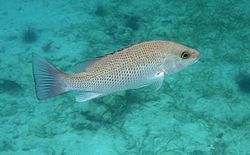- Mangrove snapper
-
Mangrove Snapper 
Scientific classification Kingdom: Animalia Phylum: Chordata Class: Actinopterygii Order: Perciformes Family: Lutjanidae Genus: Lutjanus Species: L. griseus Binomial name Lutjanus griseus
(Linnaeus, 1758)The mangrove snapper, Lutjanus griseus, is a snapper in the family Lutjanidae. It is also known as the gray snapper, mango snapper, or cabellerote.
Its color is typically greyish red, but it can change color from bright red to copper red. It has a dark stripe running through its eye if you look at it from the top when it is underwater. Its size ranges from 2–6 pounds (1–3 kg) but many biologists have now confirmed that a 29.5 pound (13.4 kg) mangrove snapper was speared off of the coast of Louisiana.
The mangrove snapper can be confused with the cubera snapper, black snapper Lutjanus cyanopterus. Mangrove snappers are typically much smaller than cubera, but when they are of similar size, the two species can only be distinguished by examining a patch of teeth (tooth patch) on the inside roof of the mouth. Many specimens caught in Florida, specifically Punta Gorda, are actually misidentified Dogtooth Snapper, a.k.a. Dog Snapper Lutjanus jocu. The best way to distinguish between the two species is that the Dogtooth Snapper has a lighter triangle of color with a blue band under the eye and large, sharp fangs in the front (canines), hence its common name. These fangs can deliver a painful bite, even in a small fish. The mangrove snapper feeds mostly on small fishes and crustaceans.
The mangrove snapper is one of, if not the most common species of snapper in warmer regions. It can be found in many areas from canals to grass flats as well as in open water. Most mangrove snapper in the open water are generally found near bottom structure or reefs. Mangrove snapper is a common target for anglers; and is highly prized for its light and flaky meat. Mangrove snapper can be caught on a variety of baits, but is typically caught with live or frozen shrimp, squid, minnows and occasionally on artificial lures or baits. Mangroves can be spearfished as well, but are sometimes a tough target as they tend to be more wary of divers, rather than curious. Mangroves are typically a wary fish, and the wariness of mangroves to eat baits tends to increase as the fish grow larger. Most mangrove snapper are caught on light to medium tackle, and typical catches range from eight inches to fourteen inches in shallow or in-shore waters, to up to 20" in deeper waters. Larger fish are uncommon, but not rare.
Chum is sometimes used by anglers to attract mangrove snapper and other species to feed and eat.
References
- Froese, Rainer, and Daniel Pauly, eds. (2006). "Lutjanus griseus" in FishBase. May 2006 version.
- Smithsonian Marine Station http://www.sms.si.edu/IRLSpec/Lutjan_griseu.htm

This Perciformes article is a stub. You can help Wikipedia by expanding it.
